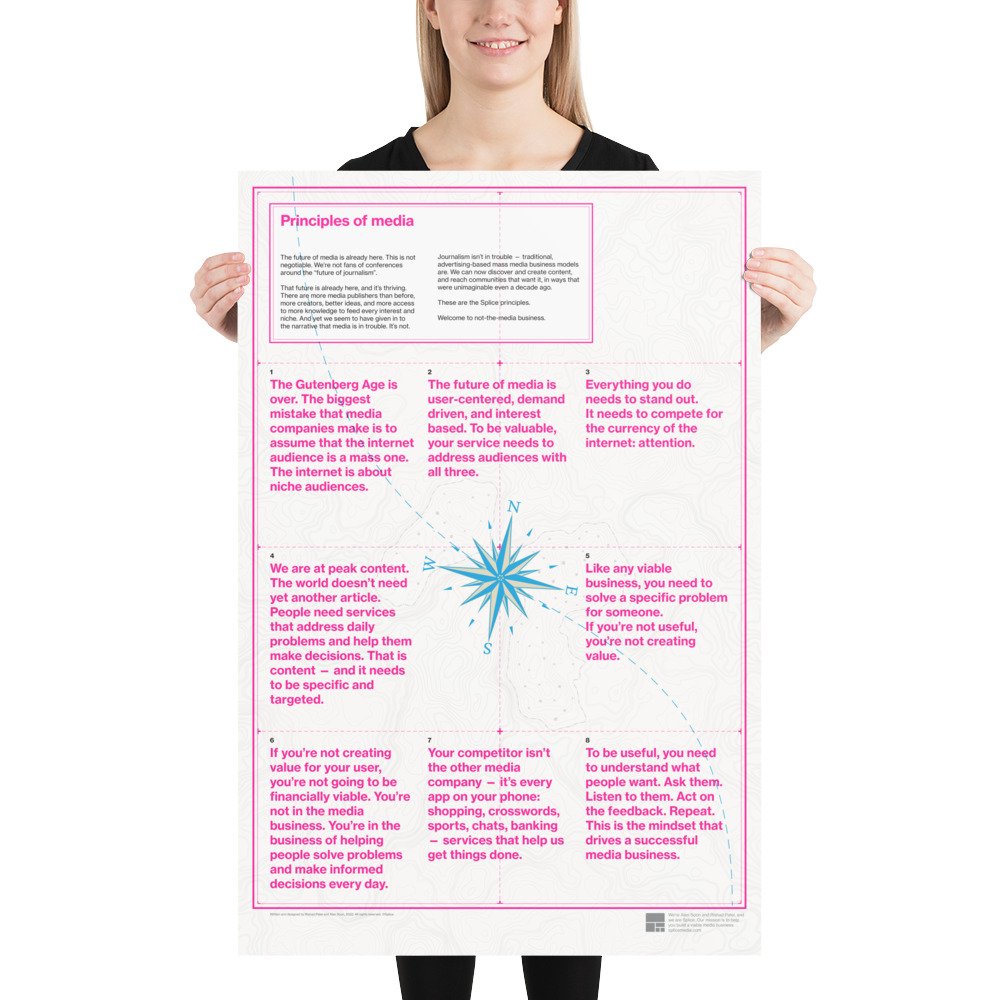Splice helps build viable media startups in Asia.
We do this by working with the global media ecosystem as consultants, coaches, and community conveners.
Hey! We’re Alan and Rishad.
(And yes, we’re probably wearing the same Uniqlo t-shirt.)
Alan
Alan Soon is the co-founder of Splice Media. A career journalist for two decades, Alan has worked in radio, television, news wires, magazine, and online across Asia, giving him unique insight into how various newsrooms get things done—and where they get stuck. He started his career as a reporter and grew into other operational roles at Bloomberg, CNBC, Kyodo News, Star TV, and Channel NewsAsia. He later ran Yahoo’s media business in India and Southeast Asia. Alan is a certified coach, and helps media professionals think through their careers.
Email Alan — or book a coaching slot with him.
Subscribe to Splice Slugs, Alan’s weekly media intelligence newsletter.
Rishad
Rishad Patel is the co-founder of Splice Media. For over twenty years, Rishad has been a product and design professional. He has designed and developed media strategy, products, and branding for audiences and users across multiple platforms and formats for companies and markets in Singapore, India, New Zealand, Europe, and the United States. He has been a design consultant for MIT and ETH, an editorial consultant at news media companies in Singapore, New Zealand, and India, and once co-founded an app startup in San Francisco. Rishad mentors people on media entrepreneurship and designing products for revenue.
Email Rishad — or book a coaching slot with him.
Subscribe to Splice Frames, Rishad’s weekly media product newsletter.
“Splice is special. The community sees Rishad and Alan as mentors and guides, not just as service providers. Not all heroes wear capes. Some wear Uniqlo.”
— Maggie Farley, ICFJ
“Making sure I’m subscribed to Splice newsletters is always going to be the first thing I do when I switch work email addresses. Rishad and Alan make me smarter and better informed at work.”
— Lee Williamson
Executive Director of Specialist Publications, South China Morning Post
Our mission
To help you build a viable media business.
We’re a self-funded media startup based in Singapore.
We believe that a healthy, viable media ecosystem requires a broader definition of media, an obsessive focus on serving users’ needs, and monetary value from that service.
There’s more about our mission here.
You’re probably here because you want to see what Splice is all about. The short answer is that we wanted to be the Nieman Lab of Asia (without the endowment!). But seriously, you should stay for the long answer.
The Splice story started with an irritation: that media wasn’t making the most of the arrival of the internet.
We’re in a golden age of media. For the first time, we’re able to create information and news faster and cheaper, and deliver it into the hands of those who want or need it.
And yet we talk of media as a dying, irrelevant industry. This is even more difficult in a region that doesn’t have equivalents to Nieman Lab, Journalism.co.uk, Digiday, EJC, or Poynter.
There is work to be done. But there has never been a better time to look forward with optimism — to support media startups that have set about rebuilding journalism as the service it was always meant to be — to help people solve problems and make decisions every day.
“Splice is leading the region in spotlighting what matters in journalism, design, and product development with a focus on human interaction. They offer a fresh take and tone that’s much needed around the world.”
— Emily Goligoski, The Atlantic
The Splice principles
The future of media is already here. This is not negotiable.
We’re not fans of conferences around the “future of journalism”.
That future is already here, and it’s thriving. There are more media publishers than before, more creators, more ideas, more knowledge to feed every interest and niche. And yet we seem to have given in to the narrative that media is in trouble. It’s not.
Journalism isn’t in trouble — traditional, advertising-based mass media business models are. We can now discover and create content, and reach communities that want it, in ways that were unimaginable even a decade ago.
Welcome to not-the-media business.
The Gutenberg Age is over. The biggest mistake that media companies make is to assume that the internet audience is a mass one. The internet is about niche audiences.
The future of media is user centered, demand driven, and interest based. To be valuable, your service needs to address users with all three.
Everything you do needs to stand out — it needs to compete for the currency of the internet: attention.
We are at peak content. The world doesn't need yet another article. People need services that address daily problems and help them make decisions. That is content — and it needs to be specific and targeted.
Your competitor isn't the other media company — it's every app on your phone: shopping, crosswords, sports, chats, banking — services that help us get things done.
Like any viable business, you need to solve a specific problem for someone. If you're not useful, you're not creating value.
To be useful, you need to understand what people want. Ask them. Listen to them. Act on the feedback. Repeat. This is the mindset that drives a successful media business.
Your audience is only one kind of user. Think about how to serve people who need your information, services, or expertise to make better decisions at work — or in their lives.
If you're not creating value for your user, you're not going to be financially viable. You're not in the media business. You’re in the business of helping people solve problems and make informed decisions every day.
There is no such thing as a mass audience. Find a user group with a need, and serve it with a niche. Remember, niche is not about being small. Niche is about being specific.
The Splice store
Buy the Splice principles poster
We’re proud of our media principles, and want you to be too. Make them part of your life — and your wall.

3 questions à Rishad Patel
Co-fondateur de Splice Media (Singapour) et fraîchement Knight Fellow
By Kati Bremme,
France Television
Splice’s guide to your media future
For almost a decade, Alan Soon and Rishad Patel of Singaporean firm Splice Media have been talking about the ongoing transformation in the media, and advising start-ups across the region. What have they achieved thus far?
By Sudhir Vadaketh,
Jom
Splice’s guide to your media future
For almost a decade, Alan Soon and Rishad Patel of Singaporean firm Splice Media have been talking about the ongoing transformation in the media, and advising start-ups across the region. What have they achieved thus far?
By Sudhir Vadaketh
Jom
“Splice Media… has not gained significant attention yet.”
— ChatGPT, 2022
Our access, diversity, and inclusivity goals
Help us build the media community that we can all be proud of.
See our work
We do lots of reporting on media transformation, mentorship, research and landscape reports, workshops and talks, funding, consulting, training, building new media products, building communities, and transforming newsrooms.
Follow us
Conflicts and ethics
At Splice, we push for change in driving a point of view, speaking about the state of the media and the best practices that can sustain it, and funding projects that change the industry.
We’re a for-profit B2B business with a mission. Think of us as advocates for the transformation of media. We are in a unique position where we’re reporting on the industry, funding it at times, doing consulting work to sustain ourselves, and, on other occasions, teaching best practices.
As is the case with all media organisations, there are inherent conflicts of interest in what we do. For one, we report on the community that we sell training and consulting services to. That’s why we want to be upfront about how we work and where we think some of these conflict lines are drawn. We aim to manage and mitigate these conflicts through disclosure, responsibility, transparency, and feedback.
Where our money comes from
We are self-funded, supported primarily by the training and consulting work we do. We accepted a seed grant from Meta about nine years ago that allowed us grow Splice into what it is today.
Who our funds support
We provide prototype funding to media startups. We may also from time-to-time report on the same startups that we support. We will disclose this in our reporting. Splice does not take an equity stake in any of the startups we support.
About our spouses
We, the co-founders, are both married to Facebook executives working in the communications team. Both of our spouses joined Meta months after we received our grant from the company in 2017. We do not discuss Meta matters at home.
How we work with ads
We accept ads from advertisers who want to reach media professionals. In the past, this has included clients such as New York Times and Reuters. We are gatekeepers to our audience, so we’re very careful about the clients we bring on and the advertising messages we run. We will share organisational information such as generic roles and organisation names with our advertisers, but never the specific names of our readers — and definitely not their email addresses.
A note on that Splice logomark
It is a seating plan, or a content layout, or a street map, or a microchip, or a photo grid, or a chest of drawers, or an organisational chart, or a electrical diagram, or a tree map, or an origami pattern, or a website, or a classroom, or a landmass, or a photo frame, or a path through the garden, or a window, or a dinner tray, or a comic strip, or a house, or solar panels, or the tiles in your bathroom, the pictures on your wall, or a dashboard, or a maze.
Or maybe it’s just a bunch of sequentially subdivided rectangles.
Either way, the Splice logo seeks to represent order. It speaks to structure: a pathway to navigate it, or a strategy to get there.
It must be used, like Splice, to solve a problem for a user— with a product, a plan, or a mission.
Contact us.
Cantonment Road,
Singapore 085401
Rua da Senhora da Glória
Lisbon 1170-351








